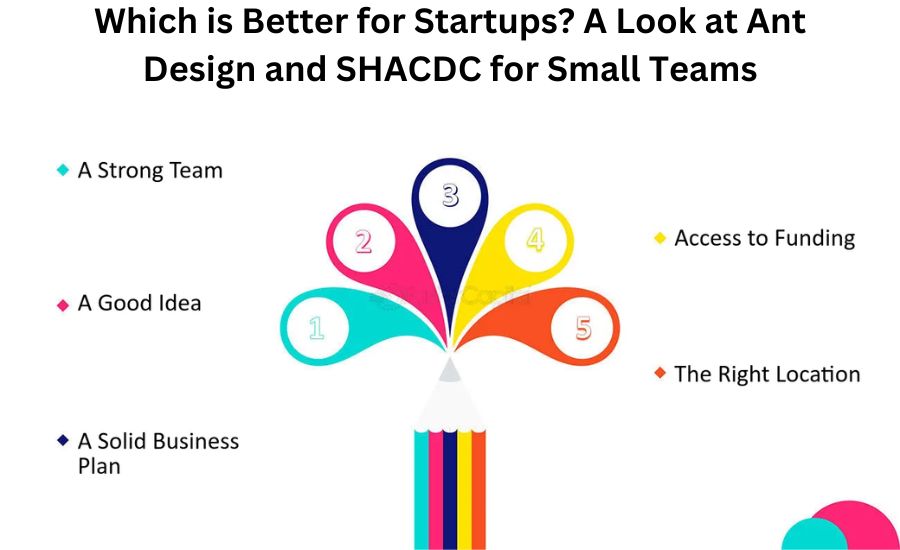Ant Design or SHACDC – the choice between these two popular UI frameworks can significantly impact the look, feel, and functionality of your next web project. Whether you’re developing for a sleek, user-friendly interface or need a highly customizable framework, understanding the core differences between Ant Design and SHACDC is essential. Each framework brings unique strengths and serves particular purposes that can cater to various project needs.
In this guide, we’ll dive into a detailed comparison of Ant Design and SHACDC, covering their features, customization options, and best use cases. By the end of this article, you’ll have a clear understanding of which framework might best suit your requirements, helping you make an informed choice that aligns with your project goals and technical needs.
Why Choose Ant Design or SHACDC? Key Considerations
Choosing between Ant Design or SHACDC depends on the specific needs and priorities of your project. Each framework has unique features and advantages that cater to different development goals, whether you need a standardized, streamlined interface or a highly customizable, unique look for your application.
Ant Design is well-suited for projects that prioritize consistency and efficiency, particularly in corporate or enterprise settings. It offers a well-organized library of components that integrate seamlessly, making it easier for developers to build cohesive interfaces. The predefined design standards in Ant Design can help maintain a uniform appearance across various parts of an application.
Conversely, SHACDC appeals to developers who seek flexibility and creative freedom. This framework allows for more customization options, enabling developers to adapt components to specific brand aesthetics or personal preferences. It’s ideal for projects where a distinctive look is key, and where developers want more control over the visual elements of the UI.
In summary, if you’re aiming for a polished, standardized UI, Ant Design is a strong choice. For projects that require a tailored, unique design approach, SHACDC may be the better fit.
Core Features Comparison: Ant Design vs. SHACDC
| Feature | Ant Design | SHACDC |
| Component Library | Extensive library with standardized components. | Smaller library but highly customizable. |
| Customization | Limited but supports basic theme adjustments. | High flexibility; allows deep customization. |
| Ease of Use | Beginner-friendly; fast setup with pre-styled UI. | Requires more effort to style, suited for experts. |
| Performance | Optimized for speed with responsive components. | Performance depends on customization level. |
| Design Consistency | High consistency across components. | Requires manual work to maintain consistency. |
| Mobile-First Support | Built-in responsive grid system. | Flexible for mobile but requires adjustments. |
| Documentation | Comprehensive and widely supported by community. | Growing documentation and community support. |
Ease of Use: Which Framework is More Developer-Friendly?
When selecting a UI framework, ease of use can significantly impact the development process. Let’s explore the different aspects of developer-friendliness in Ant Design and SHACDC.
Quick Setup and Installation
Both frameworks offer fairly simple setup processes, but Ant Design is known for its quick and straightforward installation, especially for those familiar with React. Its ready-made components and clear documentation make it easy to get started, even for beginners. SHACDC, while also easy to install, might require more configuration if you’re aiming for a customized look.
Learning Curve for Developers
Ant Design has a shorter learning curve due to its structured components and organized documentation. Developers, especially those new to UI frameworks, often find it easier to grasp because of its user-friendly design system. SHACDC, on the other hand, has a steeper learning curve as it requires more styling and customization knowledge to unlock its full potential.
Customization Ease
Ant Design provides limited customization, which makes it faster and easier for developers to implement but may feel restrictive for advanced custom needs. SHACDC shines here, offering extensive customization options. While this flexibility is beneficial for creating unique designs, it may require more development time and effort.
Customization Options in Ant Design or SHACDC

Customization is a key factor when choosing between Ant Design or SHACDC. Ant Design offers customization through its theming capabilities, allowing developers to adjust colors, typography, and certain layout aspects. However, its components are designed with a specific style language, which can limit customization depth for some unique design needs.
SHACDC, by contrast, excels in customization. Developers using SHACDC can easily modify component styles, layouts, and animations, making it ideal for projects with specific branding requirements. SHACDC’s open-ended design enables nearly limitless flexibility, which can be advantageous for developers aiming for a tailored visual identity.
If full customization is a priority, SHACDC may be the better choice. For those who prefer a standardized look with moderate customization options, Ant Design offers a balanced approach.
You May Also Like: Can-You-Build-A-Honeypot-On-Casa-Os
Performance and Speed: Ant Design vs. SHACDC
Performance is crucial in modern web development, and comparing Ant Design or SHACDC on this basis reveals some distinctions. Ant Design, with its optimized codebase and efficient components, tends to perform well in most applications. The framework is designed to be lightweight and responsive, minimizing load times and ensuring smooth transitions.
SHACDC also maintains good performance, but because it allows more customization, developers need to carefully manage component complexity to prevent performance slowdowns. The flexibility of SHACDC can sometimes lead to increased rendering times if not optimized correctly.
Both frameworks can deliver good performance if used thoughtfully. Ant Design may offer a slightly faster experience out of the box, while SHACDC’s performance depends on the extent of customization applied.
Design Consistency: How Ant Design and SHACDC Compare
| Aspect | Ant Design | SHACDC |
| Component Standardization | Highly standardized components with cohesive styling across the board. | Offers flexible component design; requires manual consistency. |
| Built-In Design Language | Follows a clear design language that ensures uniformity. | No strict design language; allows for unique visual identities. |
| Color and Theme Consistency | Includes default themes for consistent colors and typography. | Customizable themes; consistency relies on developer’s styling choices. |
| Layout Uniformity | Provides grid and layout guidelines for consistent structure. | Supports custom layouts, but needs developer oversight to maintain uniformity. |
| Ease of Consistent Styling | Easy to achieve a uniform look with minimal adjustments. | Flexibility can lead to inconsistencies if not carefully managed. |
| Best for | Ideal for projects needing a polished, professional appearance. | Suitable for creative projects requiring unique visual elements. |
Component Library: What’s Included in Ant Design or SHACDC?
The component library is another area where Ant Design and SHACDC differ significantly. Ant Design’s component library is extensive, including buttons, menus, forms, tables, and modals. These components are pre-styled and ready to use, which can save time in development.
SHACDC, while it may have fewer pre-styled components, offers more customizable ones. This can be an advantage for projects that require a more original look or special functionality not covered by Ant Design’s components.
If a project requires a wide range of components with minimal customization, Ant Design may be preferable. For projects that need specialized, highly adaptable components, SHACDC’s flexibility can be advantageous.
Scalability and Flexibility: Choosing the Right Fit for Your Project

Scalability and flexibility are vital when planning a project’s future growth. Ant Design is ideal for scalable projects due to its structured components and standardization, making it easier to expand an application without major design changes.
SHACDC, while also scalable, offers more flexibility for unique requirements. This adaptability makes it a good choice for projects that may evolve in style and functionality. Developers can build on SHACDC’s customizable foundation as project needs change.
Choosing between Ant Design or SHACDC will depend on whether the project needs standardization or flexibility for future growth.
Ant Design or SHACDC for Mobile-First Design: Which One Stands Out?
For “Ant Design or SHACDC for Mobile-First Design: Which One Stands Out?”, here’s a breakdown using bullet points:
- Responsive Grid System
- Ant Design: Comes with a built-in responsive grid system, making it easier to create mobile-friendly layouts right out of the box.
- SHACDC: Supports mobile responsiveness but may require more custom work to adapt components fully for mobile screens.
- Mobile-Friendly Components
- Ant Design: Most components are designed to be responsive, making it suitable for mobile-first designs with minimal adjustments.
- SHACDC: Components are flexible but might need additional customization to ensure they look optimal on smaller devices.
- Customization for Mobile Layouts
- Ant Design: Offers moderate customization options for mobile layouts, but it’s generally more suited to standard, clean mobile designs.
- SHACDC: Allows deeper customization, giving developers control over every aspect of the mobile layout, ideal for unique or creative mobile designs.
- Ease of Mobile Optimization
- Ant Design: Faster to implement for mobile-first projects, as it’s already optimized for responsiveness.
- SHACDC: May take more time to adjust for mobile, as the customization flexibility requires careful planning for responsive behavior.
- Best Fit for Mobile-First Projects
- Ant Design: Suitable for developers seeking quick, mobile-friendly setup with minimal tweaks.
- SHACDC: Best for projects where mobile design needs to be highly unique or tailored to specific brand aesthetics.
Documentation and Community Support: Ant Design vs. SHACDC
Good documentation and community support can make a big difference in developer experience. Ant Design’s documentation is well-structured and provides clear instructions for implementation. Its large community is active, offering tutorials, forums, and third-party resources.
SHACDC has growing support, though it may not be as extensive as Ant Design. It’s gaining traction among developers who prioritize customization, and the community continues to expand.
If community and resources are important, Ant Design has a slight edge. SHACDC, however, is increasingly supported by developers passionate about customization.
Real-World Use Cases of Ant Design or SHACDC
Ant Design is frequently chosen for enterprise applications, e-commerce platforms, and complex dashboards where a structured, consistent look is essential. Its pre-styled components help developers save time and ensure a polished appearance.
Meanwhile, SHACDC is often used in creative fields, such as personal portfolios, brand-focused websites, and applications needing a unique design. The framework’s flexibility allows for tailored, visually distinctive layouts, making it suitable for projects that prioritize originality over standardization.
Which is Better for Startups? A Look at Ant Design and SHACDC for Small Teams

For startups, time efficiency and adaptability are key. Ant Design’s ready-to-use components and cohesive design system make it a good choice for startups aiming for quick deployment and consistency across interfaces.
Small teams can benefit from the straightforward setup and reliable support that Ant Design offers. On the other hand, SHACDC’s customization potential is attractive for startups wanting to build a unique brand identity. While it may require more design effort, SHACDC provides the creative freedom to make a distinctive impression in competitive markets.
Conclusion
In the end, deciding between Ant Design and SHACDC depends on what your project needs most. If you want a quick setup with ready-to-use components and a neat, consistent look, Ant Design might be the best choice. It’s great for projects where you need everything to match and work well together, making it ideal for business apps or websites where time is a big factor.
On the other hand, if your project needs a special design with lots of personal touches, SHACDC could be a better fit. With SHACDC, you get more control over the look and feel, which helps make your project stand out. It might take more time to set up, but it’s perfect for creative projects or brands that want something unique. Just think about what matters most to you—speed and ease, or creativity and flexibility and you’ll find the right fit.
Stay Updated With: LiveMintPro
FAQs
Q: What is Ant Design?
A: Ant Design is a UI framework with pre-built components that helps developers create consistent and polished designs, especially for business and enterprise applications.
Q: What is SHACDC used for?
A: SHACDC is a flexible UI framework often used in creative projects where customization and a unique look are important.
Q: Which framework is better for beginners, Ant Design or SHACDC?
A: Ant Design is generally easier for beginners due to its ready-made components and structured design system, which requires less customization.
Q: Can I customize components in Ant Design?
A: Yes, Ant Design offers some customization options, but it is more standardized. SHACDC offers more flexibility if deeper customization is needed.
Q: Is Ant Design faster to implement than SHACDC?
A: Yes, Ant Design is typically faster to implement because of its ready-to-use components and cohesive design.
Q: Which framework is more suitable for mobile-first design?
A: Both frameworks support mobile design, but Ant Design has built-in responsive features that make it slightly easier to adapt for mobile devices.





